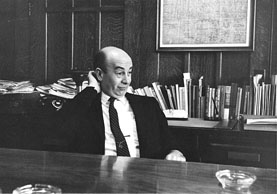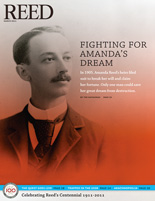
IRIS login | Reed College home Volume 90, No. 1: March 2011
Reed U: The Case for Grad School
As I read your informative and accurate article, it struck me that it might be of some interest to place the events and attitudes depicted in the context of what the college at that time was like.

Sullivan believed a grad school would strengthen Reed.
When President Sullivan took the helm of the college, it was half the size of today’s Reed. The Reed of that day had an endowment of around $1.5 million. Yes, they were different dollars, but the interest on that endowment could barely maintain the place and pay salaries. The professional administration supporting President Sullivan consisted of a registrar, a recorder, a controller, an alumni director, and a dean of women students. The admission officer was a faculty member, as was the dean of men. Much of the functional support was provided by faculty committees, and, in at least two cases, by faculty wives. Importantly, there was no development group to raise money for the college. Later in his tenure, Sullivan was able to add a vice president and an alumni fundraiser. But in his early years, as president, he was expected to do nearly everything required to keep the college afloat.
Nationally, this was a time when a number of small colleges were folding or reconfiguring. His fear that Reed could fold was real. Sullivan believed, as did other national leaders at the time, that a small college would need at least 1,800 students to be fiscally viable. Rather than triple the size of the student body, and risk diluting the quality of students, he made a couple of creative suggestions. One was the graduate school model, but another was a cluster of three colleges, each the same size of Reed of that time. One was to be a science college, another in the social sciences, and the third a literature and arts college. Together, they would bring the number of students close to 1,800. The UC Santa Cruz cluster college was the model. The faculty did not adopt this model.
To consider the graduate school proposal, one has to understand some things about the college of that day. Unlike today, there was no expectation that faculty would be engaged in scholarly activities. The senior faculty, who controlled the curriculum, had in many cases been responsible for guiding the college through the Great Depression and World War II. Their teaching and committee loads had been so heavy that only a very few were able to develop scholarly work of their own. In the late ’50s and early ’60s, new faculty were being hired who felt it important to continue the research they had started prior to their arrival on campus. Thus, a coterie of new faculty and some senior members were hungry to become reengaged in research. Sullivan understood the advantages that scholarly studies would offer for both faculty and student intellectual growth. Indeed, when Sullivan came on the scene, Reed had effectively provided for student intellectual growth, but little opportunity existed for comparable faculty growth. It was largely for this reason that many whom I knew professionally had advised me not to accept the offer I had received from Reed the year before Dick Sullivan arrived.
Sullivan also saw that the facilities, particularly those for science, were inadequate, yet the college had to compete with institutions with superior facilities. As a consequence, he raised funds for a new building to strengthen the college’s position in science. He also understood that in order to engage in scholarly work, one needed time that would not affect the quality of teaching. In this regard, he helped to raise foundation money to reduce teaching loads by enlarging departments. Across the board, he enlarged many departments, so that they could offer stronger teaching programs with additional areas of expertise. As he enlarged the faculty, he also enlarged the student body, but at a slower rate, so as to improve the student-faculty ratio. His goal of strengthening the college to make it more competitive wasn’t just in science, as the arts division was first formed on his watch.
Finally, let me point out that the only time that a major inclusionary program was ever launched at Reed was under his leadership; it was funded by the Rockefeller Foundation. Sixty-three students, drawn from minority populations, were brought to the campus. The financial crisis referred to in the article, during the latter part of his presidency, grew out of this program; he believed that the foundation had promised to continue its support when the initial grant ran out, and constructed his budget based on that assumption. Unfortunately, the money never came though, and the college found itself in financial difficulty.
My memory may be faulty on some particular points above, but of one thing I am certain: the Sullivan years were years of transition. Change is rarely easy to live with. Thus, there may have been varied responses to his leadership. Old-timers like me, and students from that period, experienced their institution during a challenging time. But a college must evolve with the times to survive. No one should expect the Reed of 50 years from now to be as it was in 2010. Through it all, though, I would hope that the educational and scholarly values of our community of learning, which served as the foundation for the Reed of Foster, our first president, will be as much in play then, as they are today.


LATEST COMMENTS
steve-jobs-1976 I knew Steve Jobs when he was on the second floor of Quincy. (Fall...
Utnapishtim - 2 weeks ago
Prof. Mason Drukman [political science 1964–70] This is gold, pure gold. God bless, Prof. Drukman.
puredog - 1 month ago
virginia-davis-1965 Such a good friend & compatriot in the day of Satyricon...
czarchasm - 4 months ago
John Peara Baba 1990 John died of a broken heart from losing his mom and then his...
kodachrome - 7 months ago
Carol Sawyer 1962 Who wrote this obit? I'm writing something about Carol Sawyer...
MsLaurie Pepper - 8 months ago
William W. Wissman MAT 1969 ...and THREE sisters. Sabra, the oldest, Mary, the middle, and...
riclf - 10 months ago